The Garden Helper's Plant of the Day ArchiveThe Plants of the Day for August 2011Below you will find an index of all the plants, flowers and trees that have been profiled as aPlant of the Day at The Garden Helper during August of 2011 |
More Plants and FlowersOctober 2010November 2010 January 2011 February 2011 March 2011 April 2011 May 2011 June 2011 July 2011 August 2011 The Plant of the Week 2011 The Plant of the Week 2012 |
August 1, 2011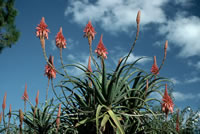 Aloe Vera Aloe barbadensis There are over 250 species of Aloes in the world, mostly native to Africa. They range in size from little one inch miniatures to massive plant colonies consisting of hundreds of 2 foot diameter plants. Flowers are a favorite nectar source for hummingbirds. The medicinal properties of Aloe Vera have been known and recorded since biblical times. Hardy in USDA zones 10-11. |
August 2, 2011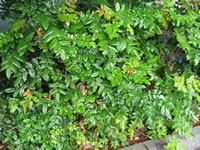 Oregon Grape Mahonia aquifolium Oregon Grape is a deer resistant, low maintenance, durable, evergreen shrub with glossy green, Holly-like foliage. It produces spikey clusters of Butterfly attracting, bright yellow flowers in the spring, followed by bluish-black berries to feed the birds. Hardy in USDA zones 5-9. |
August 3, 2011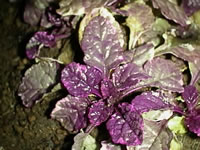 Bugleweed Ajuga genevensis Bugleweed is one of the best known and most useful ground covers because of its suitability for many different situations. The flowers may be purple, rose or white. The foliage color ranges from green to bronze to purple or variegated. Hardy in USDA zones 3-9 |
August 4, 2011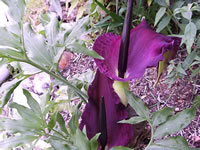 Dragon Lily Dracunculus vulgaris Dracunculus vulgaris is known by many names, Dragon Lily, Voodoo Lily, Viagra Lily and the 'tell it like it is' name of Stink Lily. Luckily the odor dissipates after the first day, allowing you to enjoy the exotic beauty of this unusual plant! Hardy in USDA zones 5-8 |
|
|
||||
August 5, 2011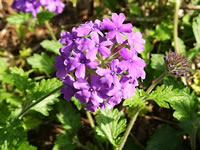 Trailing Verbena Verbena canadensis There are about 250 annual and perennial species of Verbena but there are only about a half dozen that are commonly cultivated. These easy to grow, long blooming plants are both heat and drought tolerant. Trailing forms of Verbena are excellent for growing in containers and hanging baskets. Hardiness zones vary. |
August 6, 2011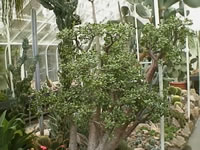 Jade Tree Plants Crassula argentea The Jade Plant originated in South Africa, and has been grown as a house plant in Europe and America for a hundred years. Very easy plants to grow if their needs are understood and met. Typically, all healthy, mature Jades will bloom, around Christmas in the northern hemisphere. Hardy in USDA zones 9-11. |
August 7, 2011 On Vacation! --> |
August 13, 2011 <-- On Vacation! |
August 14, 2011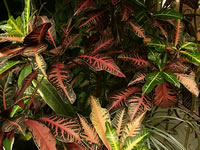 Croton Codiaeum variegatum Crotons are tender perennial plants that will grow to three feet tall or more. They are most often grown as house plants or in a greenhouse environment. Their thick, glossy foliage is brightly colored in combinations and shades of red, yellow, pink, orange, burgundy, bronze or green. Hardy in zones 11-12. |
|
|
||||
August 15, 2011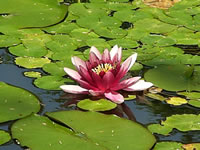 Hardy Water Lily Nymphaea tetragona There are about fifty species of Water Lily plants. Water Lilies are tuberous growing plants that can be planted in pots and submerged in your pond or even in a tub on your patio, where they will send up round, floating leaves and beautiful, sometimes fragrant, star shaped flowers to the surface. Hardy in zones 5-10. |
August 16, 2011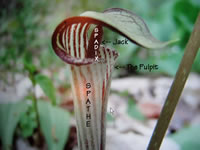 Jack in the Pulpit Arisaema species Jack in the Pulpits are distinctive, woodland wildflowers that are native to North America and parts of Asia. In spring to early summer, tiny, insignificant flowers form on the spadix (Jack), hidden down inside the hooded spathe (The Pulpit), which emerges from the middle of the foliage. Hardiness zones vary. |
August 17, 2011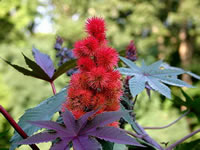 Castor Bean Ricinus communis Castor Beans are fast growing, tender perennial shrubs that are capable of growing up to 12 feet in a single season. Castor Bean plants have reddish colored stalks with very large palmate shaped, deep green to dark purple leaves that can grow up to 2 feet wide. Seeds of the Castor Bean plant are extremely poisonous! Hardy in zones 9-12. |
August 18, 2011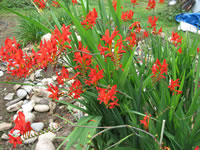 Montbretia Crocosmia crocosmiiflora Crocosmia are easy to grow, corm type plants that are related to the Gladiola, Iris and Crocus. They produce 36" stalks of brilliantly colored, tube shaped 2" flowers that open sequentially up the stem from July until the first frost of fall. Montbretia are a favorite flower of Hummingbirds and Butterflies Hardy in USDA zones 7-11 |
August 19, 2011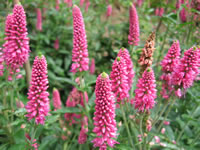 Speedwell Veronica species Speedwell are easy to care for perennial plants that fall into two main categories. The bushy or mat forming groundcovers grow anywhere from one inch to a foot tall and produce dense clusters of flowers. Tall, spiked types form large clumps and produce tight spikes of butterfly friendly, brightly colored flowers. Hardiness zones vary |
August 20, 2011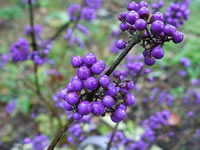 Beauty Berry Callicarpa bodinieri The foliage of the Beauty Berry plant is a beautiful bronze color as it emerges, but soon turns to a bright green. Small lavender flowers produce clusters of berries which ripen to intensely purple color, which remain on the plant after the foliage drops providing a beautiful contrast during the winter months. Hardy in USDA zones 6-8 |
August 21, 2011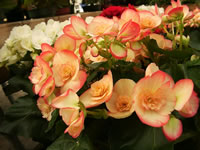 Tuberous Begonias Begonia tuberhybrida With proper care, tuberous Begonias will remain in bloom for several months, producing large clusters of single or double flowers in almost every color except for blue. Some varieties are upright plants, but the majority of tuberous Begonias grown are multi-stemmed, pendulous hanging plants. Hardy in USDA zones 9-11 |
August 22, 2011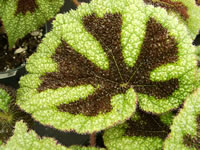 Iron Cross Begonia Begonia masoniana Iron Cross Begonias have some of the most unique foliage in the plant world. Each heavily textured, bristly, light green leaf bears a reddish-brown marking resembling the Iron Cross used on shields and flags during the Crusades of medieval times. Hardy in USDA zones 11-12 |
August 23, 2011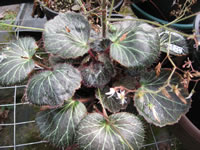 Strawberry Begonia Saxifraga stolonifera Strawberry Begonias are small, low growing, evergreen perennials that spread by runners called stolons. They have rounded, coarsely toothed, green leaves with silver marbling and covered with a fine hair, and having reddish undersides that form a loose rosette. Hardy in USDA zones 6-9 |
August 24, 2011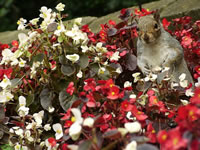 Wax Begonia Begonia semperflorens Dwarf varieties of Wax Begonia grow from 6"-8" tall. Tall varieties grow from 10"-12" tall. They have succulent stems and waxy, deep green to dark mahogany colored foliage, and they produce loose clusters of single or double, white, pink or red flowers from early May until October. Hardy in USDA zones 9-11 |
August 25, 2011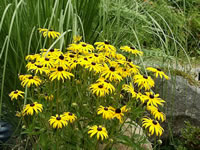 Black Eyed Susan Rudbeckia hirta Black Eyed Susan's bright yellow, daisy-like flowers grow to a height of 24-36 inches and are excellent to use in cut flower arrangements and for growing in your butterfly garden. The Black Eyed Susan is typically an annual wildflower, but some types are perennials that are hardy in USDA zones 3-10 |
August 26, 2011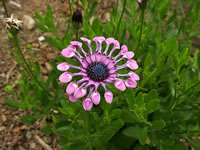 African Daisy Osteospermum barberae The blooming season of the African Daisy plant begins in early spring and continues until the first frosts of fall. The flowers of the African Daisy will only open fully on a sunny day, but even on an overcast day, they will open partially, giving you a much different effect. Annual Plant |
August 27, 2011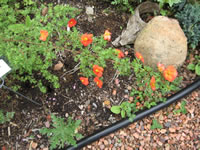 Shrubby Cinquefoil Potentilla fruticosa Shrubby Cinquefoil are a small, low maintenance, deciduous shrubs which are an excellent addition to a Butterfly Garden, or for areas where deer are a problem. Yellow or pink buttercup-like flowers appear on this 1-4 foot tall shrub in June and continue to brighten your landscape until the first frosts of Fall. Hardy in USDA zones 2-7 |
August 28, 2011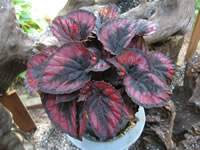 Rex Begonia Begonia rex-cultorum The Rex or Painted-Leaf Begonias are rhizomatous, clump forming, tender perennials that are normally grown as house plants. Their leaves vary considerably in texture, size, shape, patterns and colors. The inconspicuous, small, pink or white flowers may appear at any time of the year Hardy in USDA zones 10-12 |
August 29, 2011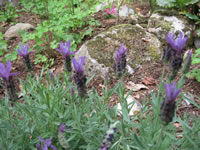 English Lavender Lavandula angustifolia Lavender prefers lots of sun but will tolerate a limited amount of shade. Well-drained soil is essential, otherwise the foliage will yellow. Lavender plants should be pruned back immediately after blooming to keep the plant compact and neat. Older, woody plants can be cut back half way when new growth begins in spring. Hardy in USDA zones 6-9 |
August 30, 2011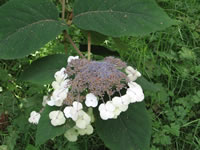 Rough-leaf Hydrangea Hydrangea aspera Hydrangea aspera will grow 10 to 12 feet tall with an 8-10 foot spread. This deciduous shrub has very large leaves that are greyish-green with a fuzzy texture on the top, and light green below. In the summer and early fall, they produce large, 10"-12", flattened flowerheads that resemble those of the Lacecap Hydrangea. Hardy in USDA zones 7-10 |
August 31, 2011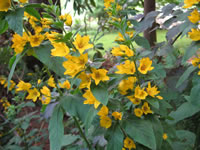 Golden Loosestrife Lysimachia punctata Golden Loosestrife is an excellent plant for bog gardens or next to ponds and streams. This 3-4 foot tall perennial has light green, 3" leaves with serrated edges. In early to mid-summer, they produce abundant spikes of star shaped, golden yellow flowers, tinged in red at the base. Can become invasive. Hardy in USDA zones 5-10 |
Beginning September 1, 2011, The Plant of the Day will be switched over to a Plant of the Week, in order to free up a little more of my time.
The Plant of the Week |
||
Search The Garden Helper: